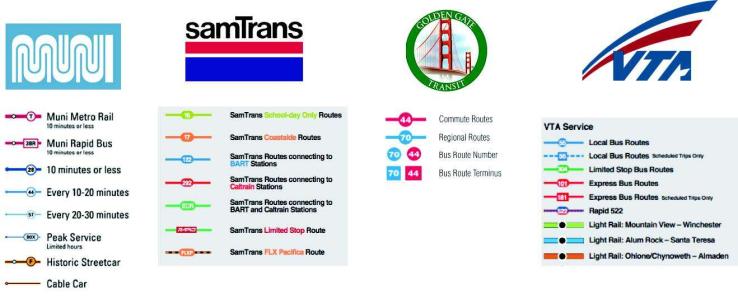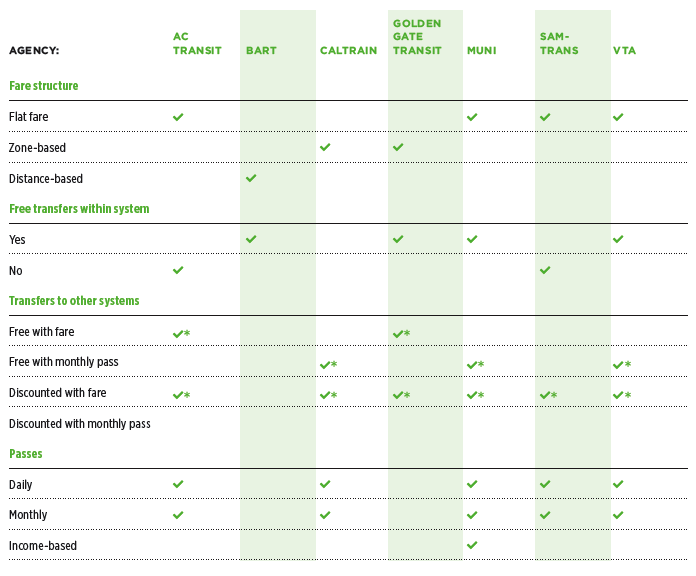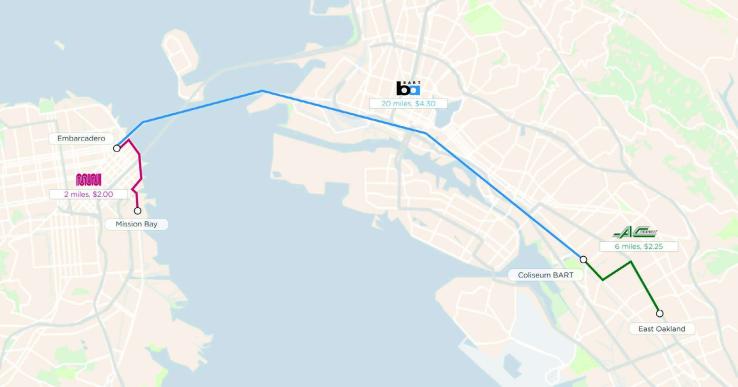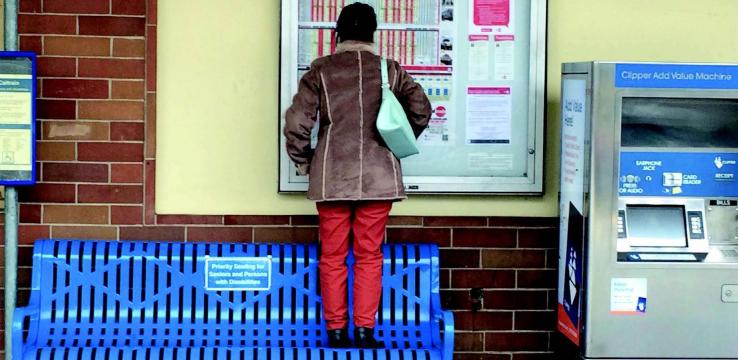The ability to hop between the Bay Area’s many transit systems easily. A cohesive transit map that knits together the region’s many transit services. Timetables and stations that facilitate smooth transfers between operators. Transit fares that incentivize transfers and encourage the use of multiple operators: This was SPUR’s vision for integrated public transit as outlined in our 2015 report Seamless Transit: How to Make Bay Area Public Transit Function Like One Rational, Easy-to-Use System — and we’ve been pursuing its implementation ever since.
Is this vision achievable? Bay Area public transit is particularly complicated. As outlined in Seamless Transit, more than two dozen transit operators provide services, including Muni, BART, AC Transit, the Santa Clara Valley Transportation Authority (VTA), Caltrain and many other bus, rail and ferry operators. And each transit operator has its own unique policies, procedures, operating practices, fare structures an d funding sources.
Fragmented transit makes the system less efficient and less usable: taking a trip using multiple operators requires navigating multiple maps, timetables and fares; managing schedules not coordinated for transfers; and negotiating counterintuitive transit connections. In spite of these difficulties, many riders regularly use more than one of the region’s transit operators to get where they need to go. Doing so is often a necessity. If using more than one transit service for one trip were actually seamless, it’s quite possible new riders would do the same.
Seamless Transit put forth a bold but simple answer to solve these problems: Bay Area transit must account for and prioritize the customer experience. It is the customer experience — the way people interact with the transit network on a daily basis — that drives people to use transit. When transit offers a great customer experience, transit agencies focus on what riders need and want — comfort and safety, ease of purchasing a fare, good customer service, accurate and timely information — and not just the bare minimum. Transit agencies need to talk to riders to unearth their expectations and desires and experience process. Jurisdiction boundaries would lose their stronghold; every decision — even the really hard ones that mandate upending years of how business has been done— would be made with the customer in mind to create simplicity for riders.
This year SPUR released two white papers that offer recommendations for implementing the big ideas in Seamless Transit. The first, Finding Transit focuses on how better maps could make the Bay Area transit system easier to understand and navigate. In many of the world’s best transit systems, the local transit map has attained iconic status — but we can’t say the same for the Bay Area, where the potential of the transit map has yet to be realized. Finding Transit aspires to maps that seamlessly integrate multiple operators designed to communicate journeys and not jurisdictions.
So Many Systems, So Little Integration
Bay Area transit maps use a wide range of styles, symbols, language, graphics and nomenclature to describe their transit service.

Finding Transit was published as part of an effort between SPUR, the Metropolitan Transportation Commission (MTC) and the Silicon Valley Community Foundation (SVCF) to develop MTC’s next regional transit map as well as shared transit map design guidelines and transit mapping platforms. The paper provides background on the role of public transit maps in helping people to navigate transit, outlines how Bay Area transit maps are currently developed, presents principles for transit map coordination and offers recommendations for moving forward.
The second white paper, Solving the Bay Area’s Fare Policy Problem, describes the region’s disjointed approach to fare policy and proposes a series of actions for how the Bay Area can deliver a new vision for fare policy, one that prioritizes the region and the rider. Every day, people in the Bay Area make the choice not to use transit — not because it isn’t reliable or frequent enough but simply because transit fares are confusing, intimidating and unaffordable. The region’s fare policies should encourage the use of transit for all types of trips, support access to transit for people of all income levels and reward people for making the choice to use transit, instead of penalizing them for transferring from one operator to another.
Fare Policies Differ Across Bay Area Transit Operators
What if fare structures, transfer policies and products were integrated across Bay Area transit operators?

Three particularly urgent and salient actions are called out in the white paper: the need for information on the actual impacts of regional fare streamlining and integration; the need to incentivize coordination and manage the risk of falling revenues from fare streamlining and integration; and the need to determine a body to officially oversee regional fare policy, as the absence of such an entity has allowed the issue of disjointed fares to fester without resolution. Together, these actions form the necessary foundation for a delivering a regional approach to fare policy in the Bay Area. These are big moves, and will require significant time, effort and diligence on the part of policymakers and transit operators to realize.
Ultimately, each paper arrives at the same conclusion as Seamless Transit: that we must hold the region’s transit system to a higher standard and that transit in the Bay Area can and must deliver more for riders.

Achieving the visions laid out in these white papers will not be easy. If integrating transit were simple, we would have done so by now. Years of decisions regarding how transportation in the region is funded, delivered and governed have produced the system we have. To date, solutions have been ad hoc and piecemeal; doable, affordable fixes have gone ignored.
Moving beyond the status quo is going to require a commitment to the region and to the rider from MTC, cities and transit agencies. Solutions will also require new approaches, mind-sets and skill sets as well as detailed policy changes, agency by agency and city by city. Accounting for the customer experience will need to move from the fringe of what public transit agencies and boards focus on and become a primary activity. Financial investments and resources are also key to further regional integration efforts.
SPUR’s research and advocacy has led to real wins in the name of Seamless Transit. This year, for example, MTC debuted a new regional transit map, one of the report’s recommendations. MTC allocated nearly $1 million for the next phase of the project. A customer-focused and seamless transit fare system for the Bay Area is gaining momentum. Also earlier this year, the MTC convened transit operators for the first time in over a decade to discuss how the region can improve its collection of fare polices to make navigating Bay Area transit less complicated and cumbersome. And now, a business case to assess options, costs and benefits for fare integration is on the table. In San Jose, SPUR is deeply involved in the redesign of Diridon Station and committed to ensuring it is redesigned as a hub full of mobility options that plays a central role in the city and the region. Beyond SPUR, new advocacy groups have sprung up to advocate for a customer-first transit system and unify the Bay Area’s disparate transportation governance.
SPUR believes that the Bay Area’s transit system can — and must — offer an outstanding customer experience. With the right ideas, incentives and leadership a seamless transit system is well within our grasp.
Read Seamless Transit
Read Finding Transit
Read Solving the Bay Area's Fare Policy Problem

